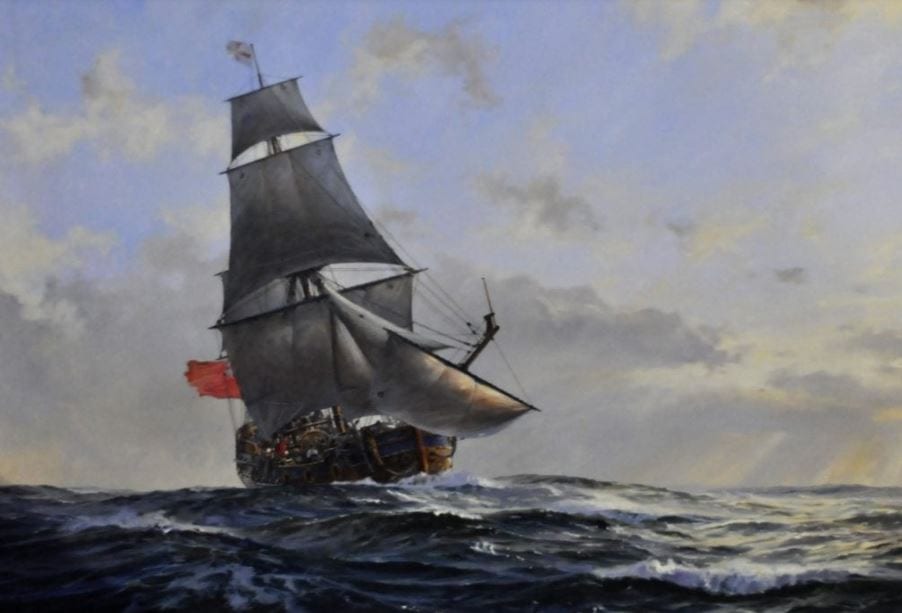One item that will be going into auction next Tuesday 23rd May is a painting by Geoffrey Hunt of the HMS Nonsuch. This painting is an oil on canvas painting showing the Nonsuch on a voyage on the open seas. Built in 1668, this 53-foot ketch was built and launched in Gravesend, England. The Nonsuch was commissioned to undertake a trans-Atlantic voyage bound for Hudson Bay, Canada. The reason for this particular voyage was to prove that a fur-trade industry, proposed by Radisson & Groseilleurs, from North America would be more efficient and adventurous through Hudson Bay than through the current set up of transporting fur from the established St. Lawrence River Route.
It took the Nonsuch 118 days to complete the journey across the Atlantic and anchored off the mouth of the ‘Rupert’ (christened ‘Rupert’ by the crew after Prince Rupert who had backed the expedition) on 29th September. By the

Painting by Geoffrey Hunt, 1991
With the fur and prime beaver pelts back in England the demand was so great for beaver felt hats that the backers of the expedition approached King Charles II and explained how lucrative this opportunity could be, and demanded a charter to be established. This gave birth to the Hudson’s Bay Company.
In 1970, a replica Nonsuch was built to celebrate its 300th anniversary by the Hudson’s Bay company, the main reason for this is because the original expedition opened up the entire west coast of Canada to trade to England. The replica can now be found in Manitoba Museum in the Nonsuch Gallery.
We believe that this painting has a truly fascinating history behind it and is rightly valued at approximately £4,500. you will have the opportunity this coming Tuesday to bid for this magnificent painting. The Nonsuch was also famously mentioned in CS Forester’s The Commodore, which explored the fictional journey of Horatio Hornblower through the Late 1700’s and Early 1800’s. Please see excerpt of this terrific book where Nonsuch was mentioned:
The squadron uses naval mortars (carried on special ships known as bomb vessels), one of which is the Harvey. After Russia enters the war, Hornblower’s squadron takes an important role in the defence of Riga, which is besieged by French forces. The bomb vessels take an important role, and so do amphibious operations under the protection of the squadron. Off Elsinore, Harvey is hit: “…Nonsuch heaved over; her backed topsail caught the wind and checked her way as she recovered. She hovered with the battered Harvey close alongside Horn blower could see Mound her captain directing the efforts of her crew from his station at the foot of her mizzenmast. Hornblower put his speaking-trumpet to his lips. “Cut that wreckage away, smartly, now” “Stand by for the line!” Hurst Shouted.
The heaving-line, well thrown, dropped across her mizzen shrouds, and Mound himself seized it; Hurst dashed below to superintend the passing across of the towline, which lay on the lower gun-deck all ready to be passed out of an after gun-port. A splintering crash forward told that one shot at least from Amager had struck home on Nonsuch axes were cutting furiously at the tangle of shrouds over the Harvey’s side; a group of seamen were furiously hauling in the three-inch line from Nonsuch which had been bent on the heaving-line.
Another crash forward Hornblower swung round to see that a couple of foremast shrouds had parted at the chains. With the Nonsuch lying nearly head to wind neither port-side nor starboard-side guns bore to make reply, but Carlin had a couple of guns’ crews hard at work with hand-spikes heaving the two foremost guns round — it would be as well to keep the batteries under fire so as not to allow them to indulge in mere target practice. Hornblower turned back Nonsuch stern was almost against Harvey’s quarter, but some capable officer already had two spars out from the stern gallery to boom her off.
The big cable itself was on its way over now as Hornblower watched he saw Harvey’s men reach and grasp it….”
The siege is finally broken, and Hornblower joins the pursuit of the French armies on horseback, only to fall seriously ill with typhus.
